
Canace nascia is a European species of Canacidae.

Sepedon sphegea is a Palearctic species of fly in the family Sciomyzidae, the marsh flies or snail-killing flies. The larva feeds on aquatic snails and as an opportunist on other invertebrates. The habitat of this species includes among many others, pond margins and damp meadows. It has a particular fondness for Iris pseudacorus which grow at the edges of the pond. Adults can be found all year long but the main flight period is from March to October.

Lonchaea chorea is a species of fly in the family Lonchaeidae. It is found in the Palearctic. The larva develops in cow dung.
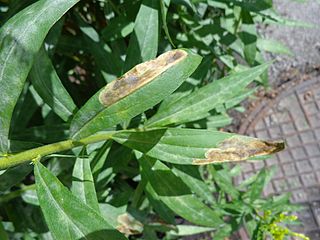
Nemorimyza posticata is a species of fly in the family Agromyzidae. It is found in the Palearctic.

Agromyza nana is a species of fly in the family Agromyzidae. It is found in the Palearctic. Description of imago-Interocular space red. Antennomeres 1 and II red. Peristoma and palps black. Dorsocentral bristles : 1 +3 subequal; acrostics in four rows. Legs black, knees red. Abdomen black with lighter pruinosity than the thorax. Long.:1,75-2,5 mm. The larva mines Trifolium pratense, Melilotus altissima, Medicago.
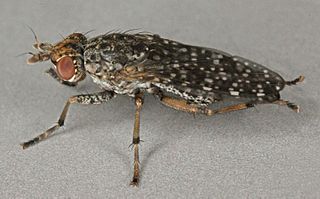
Dictya umbrarum is a species of fly in the family Sciomyzidae. It is found in the Palearctic and Nearctic. Long. : 4-5 mm. Intensely spotted wings.The interocular space with a black mark at the anterior orbital.The face is white with a black or brown central point. The antennae are reddish, the arista yellow at the base.The body is black covered in a grey yellow pruinosity with shifting (changeant) brown spots on the abdomen.The femora are grey with a brown apical band.The tibia are yellow with a brown apical ring (anneau). For terms see Morphology of Diptera. Dictya montana is a predator of aquatic pulmonate snails with no apparent parasitoid tendency.

Elgiva cucularia is a species of fly in the family Sciomyzidae. It is found in the Palearctic .Long. : 5-8 mm.Overall it is coloured yellowish-brown with a bluish-gray body. The head is characterized by silky black dots at the bases of the anterior orbital setae, between the bases of the antennae and the edges of the compound eyes, and in the centre of the occiput. The third antenna segment is a little shorter than the second. The mesonotum is black with a grey ground and grey pruinosity.There are longitudinal, brown stripes on the dorsum of the thorax: two narrow in the middle and two wide on the sides. One mesopleural bristle amongst short setae.The prothorax is bare. The yellowish smoky wings are 5.2 to 6.8 mm long and have fuzzy spots on the front half. The legs and abdomen are yellow. The lower surfaces of the hind femora are equipped with setae, while the front pair lacks them.The abdomen is rufous.For terms see Morphology of Diptera. Larvae of E. cucularia are predators of aquatic, pulmonate snails in the families Lymnaeidae, Physidae, and Planorbidae.
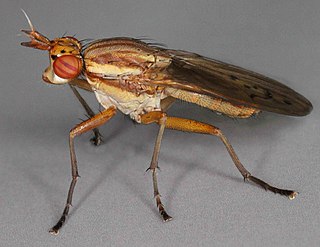
Ilione albiseta is a species of fly in the family Sciomyzidae. It is found in the Palearctic .The body length is 8 to 11.2mm and the basic colour is yellowish-brown. The spot on the occiput, the spots at the base of the frontal orbital setae and the almost triangular spots at the edge of the eyes at the height of the antennae are silky dark brown. The long antennae have a whitish hairy arists. There are longitudinal, brown stripes on the yellowish-dustedmesonotum : two narrow in the middle and two wide on the sides. In addition, there is a brown band on the body below the notopleura. The prosternum is bare. Chaetotaxy of the thorax shows strong presutural acrostichal setae and 2–3 well-developed subalar setae. The wings are 6.8 to 8 mm long and usually have 5 marks: on the anterior transverse vein, the medial vein, and the two ends of the posterior transverse vein. If there are only 2 dots on the medial vein, the transverse veins are at least darkened. The legs are yellow with darkened tarsi. The lower surfaces of the femora of the hind legs are equipped with strong and dense setae in males, and with short and sparse setae in females. Males are characterized by a copulatory apparatus with non-swollen abdominal pituitary glands.For terms see Morphology of Diptera. The larva preys on Galba truncatula

Limnia unguicornis is a species of fly in the family Sciomyzidae. It is found in the Palearctic.
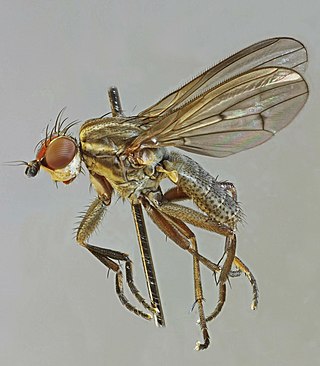
Pherbellia cinerella is a species of fly in the family Sciomyzidae. It is found in the Palearctic. P. cinerella is a dark and very characteristic Pherbellia and easy to recognise in the field by its long mid-frontal stripe and darkened anterior wing margin. The larva is predatory on a variety of terrestrial and aquatic snails including Helicidae, Galba truncatula, Helix, Helicella, Succinea and Lymnaea.There is little or no host preference. It is found in a wide range of habitats but it is most often found in warm and dry habitats such as coastal dunes and calcareous grassland where it can reach high numbers. It is also encountered in moist vegetation though in lesser numbers. It is a potential biological control agent.

Pherbellia schoenherri is a species of fly in the family Sciomyzidae. It is found in the Palearctic .4-5 mm. long. In schoenherri the grey ocellar plate is extended in a narrow triangle almost to the antenna base. The prescutellar acrostichal bristles are reduced or absent.The costal vein of the patterned wings are equipped with a series of protruding spinules distinct from the bristles. The females lay eggs on the shells of Succineidae including Succinea putris. The resultant larvae consume the animal and pupate within the shell. P. schoenherri is a very common and widespread species with a very long flight period. It flies mainly from April to October, but in most European countries, it occurs all year round and in a very wide variety of both dry and moist habitats.

Pherbellia ventralis is a species of fly in the family Sciomyzidae. It is found in the Palearctic. Pherbellia ventralis is a small sciomyzid. The body is dark grey blue to blue grey contrasting with the yellowish brown abdomen.The mid-frontal stripe is short. The larvae feed on aquatic snails including Stagnicola palustris.

Pteromicra angustipennis is a species of fly in the family Sciomyzidae. It is found in the Palearctic. It is a small sciomyzid with 1 + 2 dorsocentral bristles.The transverse veins of the wings have no shadows but they are distinctly shaded at the apex. The larvae predators of terrestrial snails or stranded freshwater pulmonate snails.

Tetanocera elata is a species of fly in the family Sciomyzidae. It is found in the Palearctic Larvae of T. elata are known obligate feeders on slugs both as parasitoids and predators.

Tetanocera robusta is a species of fly in the family Sciomyzidae. It is found in the Palearctic and Nearctic The larvae develop in aquatic pulmonate snails including Gyraulus, Helisoma, Lymnaea, Physa, Planorbis. The habitat is marshy borders of lakes and ponds and permanent marshes.

Ditaeniella grisescens is a species of fly in the family Sciomyzidae. It is found in the Palearctic.-Long. : 3.5-4 mm.The body is short, narrow, obscure above, with a rather thick yellowish ashy pruinosity. The legs are rufous with tibiae 1 and their tarsi browned. Wings clear: the subcostal cell yellow. For terms see Morphology of Diptera.
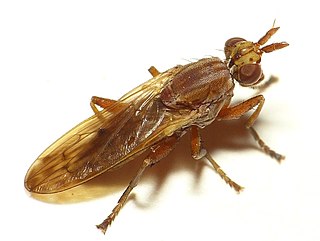
Elgiva solicita is a species of fly in the family Sciomyzidae. It is found in the Palearctic
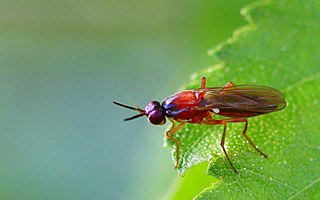
Loxocera albiseta is a species of fly in the family Psilidae. It is found in the Palearctic.The interocular space is red orange or red brown with a black triangle. Scutellum red.The face lacks a black median band.The anterior mesonotum is largely black, the posterior red without black. For terms see Morphology of Diptera.

Pherbellia nana is a species of fly in the family Sciomyzidae. It is found in the Palearctic

Renocera stroblii is a species of fly in the family Sciomyzidae. It is found in the Palearctic




















